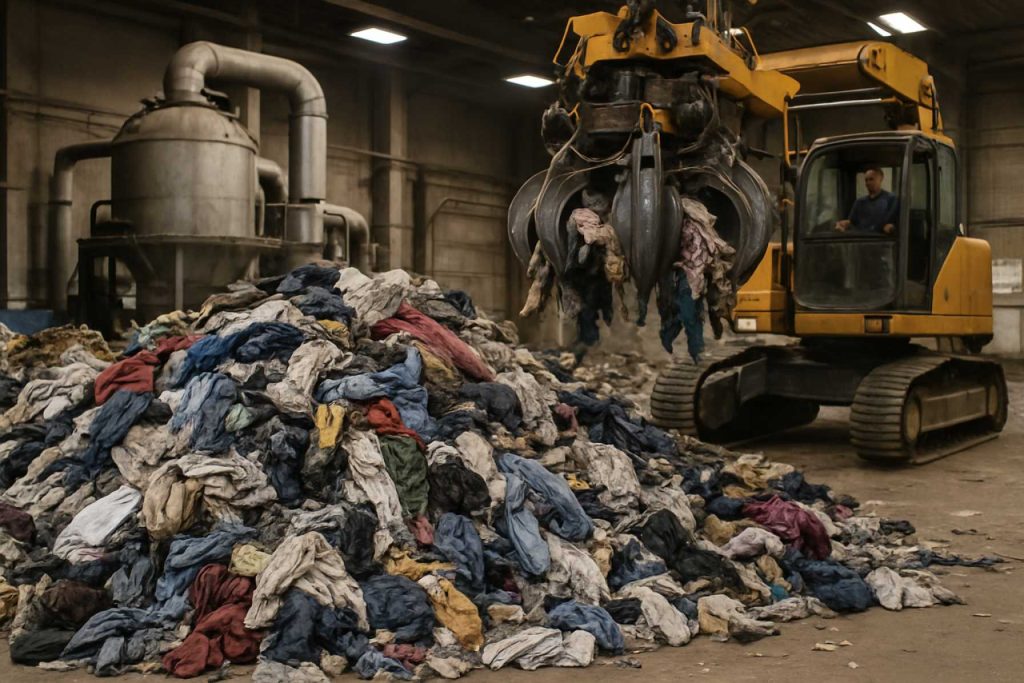
2025 Textile Waste-to-Energy Conversion Technologies Market Report: Trends, Growth Forecasts, and Strategic Insights. Explore Key Innovations, Regional Leaders, and Opportunities Shaping the Next 5 Years.
- Executive Summary & Market Overview
- Key Technology Trends in Textile Waste-to-Energy Conversion
- Competitive Landscape and Leading Players
- Market Growth Forecasts (2025–2030): CAGR, Revenue, and Volume Analysis
- Regional Analysis: Market Share and Emerging Hotspots
- Challenges, Risks, and Barriers to Adoption
- Opportunities and Strategic Recommendations
- Future Outlook: Innovations and Policy Impacts
- Sources & References
Executive Summary & Market Overview
The textile industry, a cornerstone of global manufacturing, is facing mounting pressure to address its environmental footprint, particularly regarding textile waste. In 2025, the market for textile waste-to-energy (WtE) conversion technologies is gaining significant momentum as stakeholders seek sustainable solutions to the sector’s mounting waste problem. Textile WtE technologies encompass a range of processes—such as incineration with energy recovery, gasification, and advanced pyrolysis—that convert post-consumer and post-industrial textile waste into usable energy forms, including electricity, heat, and syngas.
According to Ellen MacArthur Foundation, over 92 million tonnes of textile waste are generated globally each year, with a substantial portion ending up in landfills or incinerated without energy recovery. The growing adoption of circular economy principles and stricter environmental regulations are driving investments in WtE technologies, particularly in regions with high textile production and consumption such as Europe, North America, and Asia-Pacific.
Market analysis by MarketsandMarkets projects the global waste-to-energy market to reach USD 54.4 billion by 2027, with textile waste representing a fast-growing segment due to increased awareness and policy support. The European Union’s Green Deal and China’s “Zero Waste Cities” initiative are catalyzing the deployment of advanced WtE facilities, while the United States is witnessing increased public-private partnerships to modernize waste management infrastructure.
Key players in the textile WtE sector include technology providers such as Veolia, SUEZ, and Covanta, who are expanding their portfolios to include specialized solutions for textile-derived feedstocks. Innovations in sorting, pre-processing, and emissions control are enhancing the efficiency and environmental performance of these systems.
- Europe leads in policy-driven adoption, with several pilot projects integrating textile WtE into municipal waste streams.
- Asia-Pacific is experiencing rapid growth, driven by urbanization and textile manufacturing hubs in China, India, and Southeast Asia.
- North America is focusing on technological innovation and scaling up commercial WtE plants.
In summary, 2025 marks a pivotal year for textile waste-to-energy conversion technologies, as regulatory, economic, and environmental drivers converge to accelerate market growth and innovation in this critical segment of the circular economy.
Key Technology Trends in Textile Waste-to-Energy Conversion
Textile waste-to-energy (WtE) conversion technologies are rapidly evolving in response to mounting environmental concerns and the global push for circular economy solutions. In 2025, the sector is witnessing significant advancements in both thermal and biological conversion methods, aimed at efficiently transforming post-consumer and post-industrial textile waste into usable energy forms such as electricity, heat, and biofuels.
Among the most prominent technologies, advanced incineration and gasification systems are gaining traction. Modern incinerators, equipped with sophisticated emission control units, are capable of handling mixed textile waste streams while minimizing the release of harmful pollutants. Gasification, which converts textile waste into syngas through partial oxidation at high temperatures, is being increasingly adopted for its higher energy efficiency and lower environmental footprint compared to traditional incineration. Companies such as Veolia and SUEZ are investing in modular gasification plants tailored for textile-rich waste streams, enabling decentralized energy production and reducing transportation emissions.
Pyrolysis is another key trend, particularly for synthetic textile waste. This process thermally decomposes polymers in the absence of oxygen, yielding liquid fuels, gases, and char. Recent innovations focus on optimizing reactor designs and catalysts to maximize energy recovery and minimize toxic byproducts. Pilot projects in Europe and Asia, supported by organizations like the European Environment Agency, are demonstrating the commercial viability of textile pyrolysis for both energy and chemical feedstock production.
On the biological front, anaerobic digestion is being explored for natural fiber textiles, such as cotton and wool. While traditionally used for food and agricultural waste, advancements in pre-treatment technologies—such as enzymatic hydrolysis—are enhancing the biodegradability of textile fibers, making anaerobic digestion a more feasible option. Research institutions and industry consortia, including the Textile Exchange, are piloting integrated systems that combine mechanical sorting, fiber recovery, and biogas production.
Digitalization and AI-driven process optimization are also shaping the sector. Smart sorting technologies, powered by machine learning, are improving the separation of textile waste streams, thereby increasing the efficiency and yield of downstream WtE processes. As regulatory frameworks tighten and landfill bans expand, these technological trends are expected to accelerate the adoption of textile waste-to-energy solutions globally in 2025 and beyond.
Competitive Landscape and Leading Players
The competitive landscape of the textile waste-to-energy (WtE) conversion technologies market in 2025 is characterized by a mix of established waste management conglomerates, innovative cleantech startups, and strategic partnerships with textile manufacturers. The sector is witnessing increased activity due to mounting regulatory pressures on textile waste reduction and the global push for circular economy models.
Key players in this market are leveraging advanced thermal, biochemical, and hybrid conversion technologies to transform post-consumer and post-industrial textile waste into electricity, heat, and alternative fuels. Notable incumbents such as Veolia and SUEZ have expanded their portfolios to include textile-specific WtE solutions, often through acquisitions or joint ventures with technology providers. These companies benefit from established waste collection networks and large-scale processing infrastructure, enabling them to offer integrated services from waste sourcing to energy generation.
Emerging technology firms are also shaping the competitive landscape. Companies like Wastetextile and Renewcell are pioneering chemical recycling and pyrolysis methods tailored for mixed-fiber and contaminated textile streams. Their proprietary processes address the technical challenges of fiber separation and energy recovery, positioning them as attractive partners for fashion brands seeking sustainable waste management solutions.
Strategic collaborations are a defining feature of the market in 2025. For example, HydroThane has partnered with textile manufacturers in Europe to deploy anaerobic digestion systems that convert organic-rich textile waste into biogas. Meanwhile, alliances between technology developers and apparel giants, such as those facilitated by the Global Fashion Agenda, are accelerating the commercialization of scalable WtE platforms.
- Geographic Focus: Europe leads in technology adoption, driven by stringent EU waste directives, while Asia-Pacific is emerging as a high-growth region due to its large textile manufacturing base and increasing government incentives for sustainable waste management (European Union).
- Innovation Drivers: R&D investments are focused on improving energy yields, reducing emissions, and enabling the processing of blended and synthetic fibers, which have traditionally been challenging for WtE conversion (International Energy Agency).
Overall, the competitive landscape in 2025 is dynamic, with market leaders consolidating their positions through technology integration and new entrants driving innovation in textile waste valorization.
Market Growth Forecasts (2025–2030): CAGR, Revenue, and Volume Analysis
The global market for textile waste-to-energy (WtE) conversion technologies is poised for robust growth between 2025 and 2030, driven by increasing regulatory pressure to reduce landfill waste, rising energy demands, and advancements in conversion technologies. According to projections by MarketsandMarkets, the broader waste-to-energy sector is expected to achieve a compound annual growth rate (CAGR) of approximately 7–8% during this period, with the textile segment anticipated to outpace the average due to the mounting volume of post-consumer textile waste and the sector’s alignment with circular economy initiatives.
Revenue from textile WtE technologies is forecast to reach between $1.2 billion and $1.5 billion by 2030, up from an estimated $650 million in 2025. This growth is underpinned by the adoption of advanced thermal and biochemical conversion methods, such as pyrolysis, gasification, and anaerobic digestion, which are increasingly being deployed at scale in Europe, North America, and parts of Asia-Pacific. For instance, International Energy Agency (IEA) data highlights that the integration of textile waste streams into existing WtE plants is accelerating, particularly in countries with stringent landfill diversion targets.
In terms of volume, the amount of textile waste processed through WtE technologies is projected to grow from approximately 2.5 million metric tons in 2025 to over 5 million metric tons by 2030. This doubling is attributed to both policy-driven collection improvements and the scaling of dedicated textile WtE facilities. The European Environment Agency (EEA) notes that the EU’s push for mandatory textile waste collection by 2025 will significantly boost feedstock availability for WtE conversion, further supporting market expansion.
- CAGR (2025–2030): 8–10% for textile-specific WtE technologies
- Revenue (2030): $1.2–1.5 billion globally
- Volume (2030): 5+ million metric tons of textile waste processed annually
Overall, the textile waste-to-energy conversion market is set for dynamic growth, with technology innovation, regulatory mandates, and sustainability imperatives acting as primary catalysts for expansion through 2030.
Regional Analysis: Market Share and Emerging Hotspots
The regional landscape for textile waste-to-energy (WtE) conversion technologies in 2025 is characterized by significant disparities in market share and the emergence of new hotspots driven by regulatory frameworks, industrialization, and sustainability initiatives. Europe continues to dominate the market, accounting for the largest share due to stringent waste management policies, ambitious circular economy targets, and robust investments in advanced WtE infrastructure. Countries such as Germany, the Netherlands, and Sweden have established mature WtE sectors, leveraging both incineration and advanced thermochemical processes to convert textile waste into electricity and heat. The European Union’s Green Deal and the Waste Framework Directive have been instrumental in accelerating adoption and innovation in this region (European Commission).
In the Asia-Pacific region, China and India are rapidly emerging as key growth hotspots. China’s aggressive push to address mounting textile waste, coupled with government incentives for renewable energy, has spurred investments in pyrolysis and gasification plants. The “Zero Waste City” initiative and the 14th Five-Year Plan have further catalyzed the deployment of WtE technologies in major urban centers (International Energy Agency). India, facing similar waste management challenges, is witnessing increased public-private partnerships and pilot projects, particularly in textile manufacturing hubs like Gujarat and Tamil Nadu. The region’s growth is also supported by a burgeoning textile industry and rising environmental awareness.
North America, led by the United States, holds a significant but comparatively smaller market share. The region’s progress is hampered by lower landfill costs and less stringent regulations, though states like California and New York are piloting advanced WtE projects as part of broader decarbonization strategies. The U.S. Environmental Protection Agency’s focus on sustainable materials management is expected to gradually boost adoption (U.S. Environmental Protection Agency).
- Europe: Market leader, driven by policy and infrastructure.
- Asia-Pacific: Fastest-growing, with China and India as emerging hotspots.
- North America: Moderate growth, with innovation concentrated in select states.
Looking ahead, Southeast Asia and Latin America are poised to become new hotspots, as urbanization and textile production intensify, and governments seek sustainable waste management solutions. Strategic investments and technology transfer from established markets are expected to accelerate the adoption of textile WtE conversion technologies in these regions.
Challenges, Risks, and Barriers to Adoption
The adoption of textile waste-to-energy (WtE) conversion technologies faces a complex array of challenges, risks, and barriers that hinder widespread implementation, despite growing interest in sustainable waste management. One of the primary challenges is the heterogeneous composition of textile waste, which often contains a mix of natural fibers, synthetics, dyes, and chemical finishes. This variability complicates the preprocessing and sorting required for efficient energy recovery, increasing operational costs and reducing process efficiency. Technologies such as pyrolysis and gasification are sensitive to feedstock consistency, and the presence of contaminants can lead to equipment fouling, emissions issues, and suboptimal energy yields.
Regulatory and environmental risks also pose significant barriers. Textile WtE processes can generate hazardous byproducts, including dioxins, furans, and heavy metals, particularly when synthetic fibers and chemical additives are present. Stringent emissions standards, such as those enforced by the U.S. Environmental Protection Agency and the European Commission Directorate-General for Environment, require advanced pollution control systems, which add to capital and operational expenditures. Non-compliance risks not only legal penalties but also reputational damage, especially as public scrutiny of waste incineration and related technologies intensifies.
Economic barriers remain substantial. The capital investment required for advanced WtE facilities is high, and the return on investment is often uncertain due to fluctuating energy prices and the relatively low calorific value of many textile waste streams. According to International Energy Agency analyses, the financial viability of WtE projects is highly sensitive to feedstock availability, local energy markets, and policy incentives. In regions lacking supportive regulatory frameworks or subsidies, project financing can be particularly challenging.
Social acceptance and market readiness are additional hurdles. Public opposition to WtE plants, often rooted in concerns over air quality and health impacts, can delay or derail projects. Furthermore, the textile industry’s fragmented supply chain complicates the aggregation and consistent supply of suitable waste materials. As noted by Textile Exchange, the lack of standardized collection and sorting infrastructure for post-consumer textiles limits feedstock reliability and scale.
In summary, while textile waste-to-energy conversion technologies offer promising solutions for sustainable waste management, their adoption in 2025 is constrained by technical, regulatory, economic, and social barriers. Overcoming these challenges will require coordinated efforts across policy, industry, and technology development to ensure safe, efficient, and economically viable deployment.
Opportunities and Strategic Recommendations
The textile waste-to-energy (WtE) conversion sector is poised for significant growth in 2025, driven by mounting regulatory pressures, sustainability commitments, and technological advancements. As global textile production continues to rise, so does the volume of post-consumer and post-industrial textile waste, creating both an environmental challenge and a resource opportunity. The shift towards circular economy models and the tightening of landfill regulations in regions such as the European Union and North America are accelerating the adoption of WtE solutions for textile waste streams.
Key opportunities in 2025 include the scaling of advanced thermal conversion technologies, such as pyrolysis and gasification, which can efficiently process mixed and contaminated textile waste that is unsuitable for mechanical recycling. These methods not only reduce landfill dependency but also generate valuable outputs such as syngas, bio-oil, and char, which can be used for energy generation or as feedstocks for the chemical industry. Companies investing in modular, decentralized WtE units are well-positioned to serve urban centers and textile manufacturing hubs, where waste aggregation and logistics are critical considerations.
Strategically, partnerships between textile manufacturers, waste management firms, and energy utilities are essential to secure feedstock supply and offtake agreements for energy or byproducts. For example, collaborations with fashion brands committed to sustainability can ensure a steady stream of pre-sorted textile waste, while alliances with local governments can facilitate permitting and infrastructure development. Additionally, leveraging digital platforms for waste tracking and supply chain transparency can enhance operational efficiency and compliance with extended producer responsibility (EPR) regulations.
- Investment in R&D: Companies should prioritize research into catalytic processes and hybrid systems that improve energy yields and reduce emissions, aligning with evolving environmental standards (International Energy Agency).
- Market Expansion: Emerging markets in Asia-Pacific and Latin America, where textile production is concentrated and waste management infrastructure is developing, offer significant growth potential (McKinsey & Company).
- Policy Engagement: Active participation in policy dialogues can help shape favorable regulatory frameworks and access government incentives for circular economy initiatives (European Environment Agency).
In summary, the textile waste-to-energy sector in 2025 presents robust opportunities for technology providers, investors, and value chain partners who can innovate, collaborate, and adapt to a rapidly evolving regulatory and market landscape.
Future Outlook: Innovations and Policy Impacts
The future outlook for textile waste-to-energy (WtE) conversion technologies in 2025 is shaped by a convergence of technological innovation and evolving policy frameworks. As the global textile industry grapples with mounting waste and sustainability pressures, WtE solutions are gaining traction as a viable pathway to reduce landfill dependency and recover value from discarded textiles.
On the innovation front, advancements in thermochemical and biochemical conversion processes are expected to accelerate. Pyrolysis and gasification technologies are being refined to handle mixed textile feedstocks, including blends of natural and synthetic fibers, with improved energy yields and lower emissions. Companies are piloting modular, decentralized WtE units that can be deployed closer to waste generation sites, reducing transportation costs and carbon footprint. Additionally, research into enzymatic hydrolysis and microbial fermentation is opening new avenues for converting cellulose-rich textile waste into biofuels and biochemicals, further diversifying the product slate beyond electricity and heat Ellen MacArthur Foundation.
Policy developments in 2025 are poised to play a pivotal role in scaling these technologies. The European Union’s Green Deal and Circular Economy Action Plan are driving member states to implement stricter landfill bans and extended producer responsibility (EPR) schemes for textiles, creating a regulatory push for alternative waste management solutions European Commission. In the United States, several states are considering incentives for renewable energy generation from non-recyclable waste streams, including textiles, while China’s “Zero Waste Cities” initiative is fostering public-private partnerships to pilot textile WtE projects International Energy Agency (IEA).
Looking ahead, the integration of digital technologies such as AI-driven sorting and feedstock characterization is expected to enhance process efficiency and feedstock quality, addressing a key barrier to commercial viability. However, the sector faces challenges related to capital costs, public acceptance, and the need for harmonized standards to ensure environmental safety. Strategic collaborations between technology providers, waste management firms, and policymakers will be critical to overcoming these hurdles and unlocking the full potential of textile WtE conversion in the coming years.
Sources & References
- Ellen MacArthur Foundation
- MarketsandMarkets
- Veolia
- SUEZ
- Covanta
- European Environment Agency
- Textile Exchange
- Renewcell
- HydroThane
- Global Fashion Agenda
- European Union
- International Energy Agency
- European Commission
- European Commission Directorate-General for Environment
- McKinsey & Company



